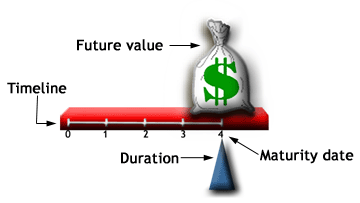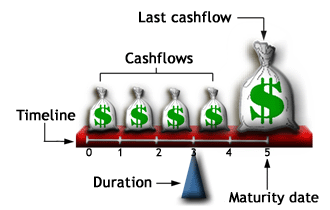Bond Duration
A Bond Duration is a time interval duration that is required to recover the true cost of a financial bond or asset.
- Context:
- It ranges from being a Zero-Coupon Bound to being a Vanilla Bond Duration.
- …
- Example(s):
- Counter-Example(s):
- See: Finance, Asset, Cash Flow, Financial Bond, Financial Yield, Macaulay Duration, Modified Duration, Zero-Coupon Bond, Dollar.
References
2017a
- (Wikipedia, 2017) ⇒ https://en.wikipedia.org/wiki/Bond_duration Retrieved:2017-7-1.
- In finance, the duration of a financial asset that consists of fixed cash flows, for example a bond, is the weighted average of the times until those fixed cash flows are received.
When an asset is considered as a function of yield, duration also measures the price sensitivity to yield, the rate of change of price with respect to yield or the percentage change in price for a parallel shift in yields.[1] [2] [3]
The dual use of the word "duration", as both the weighted average time until repayment and as the percentage change in price, often causes confusion. Strictly speaking, Macaulay duration is the name given to the weighted average time until cash flows are received, and is measured in years. Modified duration is the name given to the price sensitivity and is the percentage change in price for a unit change in yield.
Both measures are termed "duration" and have the same (or close to the same) numerical value, but it is important to keep in mind the conceptual distinctions between them. [4] Macaulay duration is a time measure with units in years, and really makes sense only for an instrument with fixed cash flows. For a standard bond the Macaulay duration will be between 0 and the maturity of the bond. It is equal to the maturity if and only if the bond is a zero-coupon bond.
Modified duration, on the other hand, is a derivative (rate of change) of price and measures the percentage rate of change of price with respect to yield. (Price sensitivity with respect to yields can also be measured in absolute (dollar or euro, etc.) terms, and the absolute sensitivity is often referred to as dollar (euro) duration, DV01, BPV, or delta (δ or Δ) risk). The concept of modified duration can be applied to interest-rate sensitive instruments with non-fixed cash flows, and can thus be applied to a wider range of instruments than can Macaulay duration. Modified duration is used more often than Macaulay duration.
For every-day use, the equality (or near-equality) of the values for Macaulay and modified duration can be a useful aid to intuition. For example a standard ten-year coupon bond will have Macaulay duration somewhat but not dramatically less than 10 years and from this we can infer that the modified duration (price sensitivity) will also be somewhat but not dramatically less than 10%. Similarly, a two-year coupon bond will have Macaulay duration somewhat below 2 years, and modified duration somewhat below 2%. (For example a ten-year 5% par bond has a modified duration of 7.8% while a two-year 5% par bond has a modified duration of 1.9%.)
- In finance, the duration of a financial asset that consists of fixed cash flows, for example a bond, is the weighted average of the times until those fixed cash flows are received.
- ↑ Hull, John C. (1993), Options, Futures, and Other Derivative Securities (Second ed.), Englewood Cliffs, NJ: Prentice-Hall, Inc., pp. 99–101
- ↑ Brealey, Richard A.; Myers, Stewart C.; Allen, Franklin (2011), Principles of Corporate Finance (Tenth ed.), New York, NY: McGraw-Hill Irwin, pp. 50–53
- ↑ Coleman, Thomas. “A Guide to Duration, DV01, and Yield Curve Risk Transformations". Social Science Research Network. SSRN 1733227 Freely accessible.
- ↑ When yields are continuously compounded Macaulay duration and modified duration will be numerically equal. When yields are periodically compounded Macaulay and modified duration will differ slightly, and there is a simple relation between the two.
2017b
- (Investopedia, 2017) ⇒ Advanced Bond Concepts: Duration http://www.investopedia.com/university/advancedbond/advancedbond5.asp Retrieved: 2017-07-01
- QUOTE: The term duration has a special meaning in the context of bonds. It is a measurement of how long, in years, it takes for the price of a bond to be repaid by its internal cash flows. It is an important measure for investors to consider, as bonds with higher durations carry more risk and have higher price volatility than bonds with lower durations.
For each of the two basic types of bonds the duration is the following:
- QUOTE: The term duration has a special meaning in the context of bonds. It is a measurement of how long, in years, it takes for the price of a bond to be repaid by its internal cash flows. It is an important measure for investors to consider, as bonds with higher durations carry more risk and have higher price volatility than bonds with lower durations.
- 1. Zero-Coupon Bond – Duration is equal to its time to maturity.
- 2. Vanilla Bond - Duration will always be less than its time to maturity.
- Let's first work through some visual models that demonstrate the properties of duration for a zero-coupon bond and a vanilla bond.
- Duration of a Zero-Coupon Bond
- The red lever above represents the four-year time period it takes for a zero-coupon bond to mature. The money bag balancing on the far right represents the future value of the bond, the amount that will be paid to the bondholder at maturity. The fulcrum, or the point holding the lever, represents duration, which must be positioned where the red lever is balanced. The fulcrum balances the red lever at the point on the time line at which the amount paid for the bond and the cash flow received from the bond are equal. The entire cash flow of a zero-coupon bond occurs at maturity, so the fulcrum is located directly below this one payment.
- Duration of a Vanilla or Straight Bond
- Consider a vanilla bond that pays coupons annually and matures in five years. Its cash flows consist of five annual coupon payments and the last payment includes the face value of the bond.
- The moneybags represent the cash flows you will receive over the five-year period. To balance the red lever at the point where total cash flows equal the amount paid for the bond, the fulcrum must be farther to the left, at a point before maturity. Unlike the zero-coupon bond, the straight bond pays coupon payments throughout its life and therefore repays the full amount paid for the bond sooner.
- (...)
- Types of Duration
- There are four main types of duration calculations, each of which differ in the way they account for factors such as interest rate changes and the bond's embedded options or redemption features. The four types of durations are Macaulay duration, modified duration, effective duration and key-rate duration.

